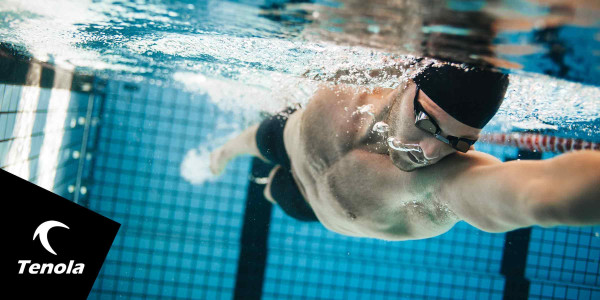
Swimming can provide a total body workout if you swim regularly. Swimming will improve your heart, define your muscles (toning) and can help you lose weight with a nutrition plan.
The number of calories you burn depends on several factors:
Your Basal Metabolic Rate (BMR) is the energy that your body requires to function correctly (i.e. blinking, eating, heart beating and accounts for approx. 70% of your energy intake). Your BMR is determined by your age, gender, body-weight and body type. Your BMR is already defined by these factors and we have very little control over them. In general, your BMR slows down as you age, men tend to burn more calories than women, the heavier you are the more calories you will burn and your body composition (muscle v fat) muscle will burn more calories than fat.
Bodyweight: Generally, the more you weigh the more calories you will burn when moving (i.e. walking, swimming etc). A calorie is just a measure of energy, so the heavier you are the more energy it takes to move your body, because the heavier person will have a greater energy expenditure when moving. The flip side is your body burns fewer calories as your weight decreases, which can lead to a weight loss plateau.
Factors we do have control of are:
Time spent swimming: Generally swimming for 30 minutes will burn less calories than swimming for 60 minutes. Swimming vigorously for 30 minutes will possibly still burn less calories than swimming moderately for 60 minutes. The more efficient swimmer you become, the fewer calories will be burnt.
Intensity of workout: The more effort you put into the swim session, the more calories will be burnt. Swim sessions are usually a mixture of intensities varying from recovery swim to fast interval sets, calculating the exact calories burnt in a session is difficult. Using swim equipment such as pull buoys, pull paddles, and parachutes all add to the intensity of a session by increasing your drag or resistance through the water. The use of swim equipment has the effect of increasing the number of calories burnt in a session.
Temperature of the water: Swimming in a controlled indoor pool environment burns less calories than swimming in a river, lake or ocean where the water temperature varies with the time of year and the climates found in different parts of the world. Studies have suggested that immersion in cold water activates an internal resource called brown fat. This brown fat, which acts like an internal heater is activated by exposure to coldness and kicks in to warm us up, unlike the white fat in the body which just stores calories. Brown fat is a type of body fat that helps control your body's temperature. This fat burns calories in order to create heat. In cooler temperatures brown fat must burn more calories to keep you warm. Also, when your body is cold, your blood moves closer to your body's core in order to keep your vital organs warm.
Stroke type: Different strokes burn different amounts of calories in a set time. Swimming breast stroke is normally seen as the least beneficial stroke for burning calories. While swimming butterfly is regarded as the most efficient stroke at burning calories. Very few (if any) swimmers can swim butterfly stroke for 60 minutes. The recommendation is to do a mixture of all 4 strokes, using the strokes at different stages during a swim session. Use a breaststroke and backstroke as a recovery between sets or cooldown. Breaststroke provides a good cardiovascular workout. It helps strengthen heart and lungs while toning thighs, upper back, triceps, hamstrings and lower legs. The backstroke works to tone the stomach, legs, arms, shoulders and buttocks. Swimming freestyle tones your stomach, buttocks and shoulders and butterfly helps with upper body strength, toning your chest, stomach, arms (particularly your triceps) and your back muscles.

How do Cycling and Running Compare to Swimming?
Again as per swimming, the number of calories burned, vary depending on BMR, bodyweight, how efficient (runner or cyclist), maintaining a constant pace, how aerodynamic, fitness level etc
Running: An athlete running at a pace of 9 minutes/mile, will on average burn between 10 – 15 calories per minute while running. Therefore a 60 minute run at this pace would burn 600 – 900 calories. Running at a faster pace will burn more calories, but run a greater distance.
Cycling: Cycling for 60 minutes at 15mph, would burn between 590 – 930 calories. Cycling for 25 miles at 18mph an athlete would burn between 12 – 18 calories per minute. Increasing your speed further to 21mph would burn 15 – 24 calories/min.
Tenola founder and CEO Ian Nolan has a lifelong love of all things active and has competed in a variety of sports over the years involving mud, sweat and tears – the latter following various serious sporting injuries! But it was the challenge of the dual or tri-disciplines of Triathlon, testing not only fitness but endurance and skill that truly captivated him and led to an ongoing passion for the sport. Read More >